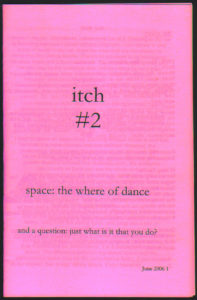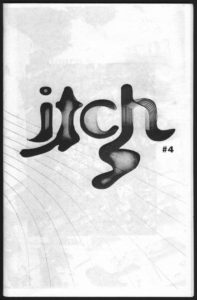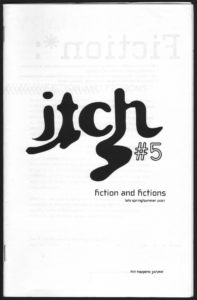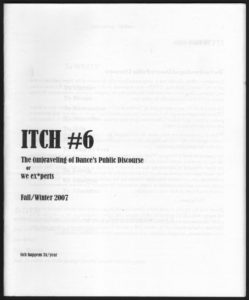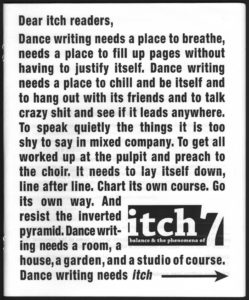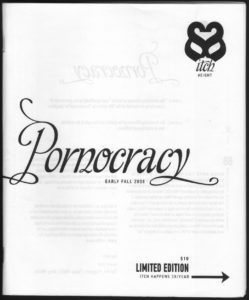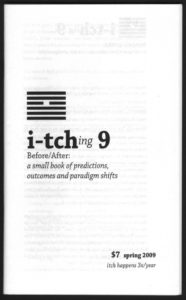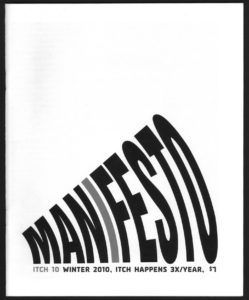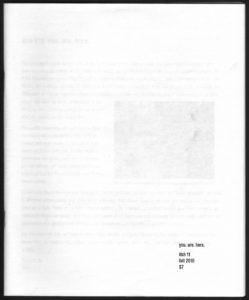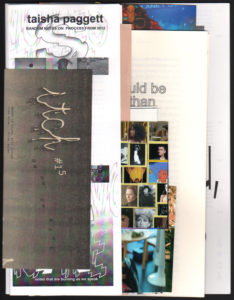2006-13
itch was an art project qua artist forum cum journal/zine that I founded and co-edited with Meg Wolfe. Additional editors over the years included dance scholar Sara Wolf, Marbles Jumbo Radio, and Lailye Weidman. We published poetry, political rants, scholarly work, one sentence email responses, cryptic fortune-cookie fortunes, photos, found images, etc., submitted from our highly elastic community of visual, performance, video, multi- and intermedia artists, dancers, choreographers, movers and the politically-inclined, all of whom have divergent interests and practices that constellate around an issue theme in a happenstance yet curiously fortuitous bricolage.
#1: Place / Community
spring 2006
CONTRIBUTORS
Faye Lim
Rogelio Lopez
Simone Forti
Yvonne Rainer
Maria Gillespie
Esther Baker-Tarpaga
Cynthia Lee
Amy Campion
Arianne MacBean
Rae Shao-Lan Blum
anonymous
CALL FOR SUBMISSIONS
What efforts do you take, as an artist in Los Angeles, to create or strengthen the dance community? And what is community anyways? Is it defined by a dance style or a dance teacher or some already canonized thus ancient/out dated classification like modern and postmodern? Is it defined by a type of cynicism and agreed upon idea of what is “good” and “bad” choreography? Is it about being queer, queer-friendly, anti-queer or none of the above? Or does it just not exist? (Or perhaps it’s just too problematic to acknowledge…?) Is defining a “community” necessary to, say, be more pro-active as an independent artist, or do you choose to just go it alone?
What do you, dancing professional, want here in Los Angeles? What would you like to see happen? What’s missing? What’s not missing? Have you any fantasies of Los Angeles being a more fertile and supportive place for yourself as a dance artist? What does that look like? Is it wrong to blame an entire city for the things that ail you as an artist? If so, who is to blame? (Or is finger pointing just one of many adolescent practices that separates you from your government and is something that you try to avoid like the plague?) Well then, what do you do? Or is there no problem, nothing to be done?
#2: Space: The where of dance
summer 2006
CONTRIBUTORS
Faye Lim
Rae Shao-Lan Blum
Erica Rebollar
taisha paggett
Jasmine Albuquerque
Amy Campion
Rebecca Alson-Milkman
with Margit Edwards, Kate Foley, Jeremy Hale, Victoria Marks, Meg Wolfe, and Ally Voye
CALL FOR SUBMISSIONS
Part 1: The where of dance:
Where do you dance? Where do you want to dance? What qualifies as a dance/performance space? What are your thoughts about dance/performance spaces here in LA and elsewhere? How do you deal with the limitations and/or possibilities of these spaces?
Part 2: A call for choreographies in the middle of supposed nowhere
Have you thought about/pursued alternatives to traditional performance spaces? Why? How? We are interested in hearing about fantasized/planned off-stage choreographies. If you could do anything, anywhere, where and what would it be?
#3: (st)itch: systems of support
fall 2006
CONTRIBUTORS
Rebecca Alson-Milkman
Rae Shao-Lan Blum
Nathalie Broizat
Esteban Cardenas
Rachel Colon
Keith Glassman
Jamm Leary/AUNTS
Jill Sigman
Kristen Smiarowski
Meg Wolfe
CALL FOR SUBMISSIONS
We are alive… and do we flourish? We are interested in constructing a discourse around the concept of Systems of Support (in whatever manner that resonates with you). How does this align with your life as a dance artist?
There exist many forms of “support” that drives one’s artistry as a dance maker. Within a field like contemporary dance, in a city like Los Angeles, in a crisis era like 2006, it seems imperative that we make use of particular systems of support to fill-in (feel in) the gaps that allow one to be productive as an artist.
What infrastructures do you make use of or self-produce – socially, emotionally, financially, creatively and otherwise – in the pursuit of making dance happen? How does your particular practice support your ability to flourish as an artist (and what does it mean to flourish in 2006 and beyond)?
Some thought stimulus from the itch generator: What interlinking social/emotional/ financial interactions go into the process of making a work or being a dancer? How does one’s artistic practice support emotional, political and/or social unrest that you/we deal with as an individual/Nation? What is the role of the audience in relation to support systems? How do you make ends meet? Grants? Donors? Personal sacrifices? How do you define or shape the social practice or collective experience that is the rehearsal? What type of support happens here? Or is your work a support system in and of itself? Is it interdependent/compulsive/conversational/investigative/responsive/social/educational/spiritual/
medicinal/supportive/resourceful/etc….?
#4: EVIDENCE
winter 2007
CONTRIBUTORS
Simone Forti
Cynthia Lee
Hana van der Kolk
Jeremy Hahn
Elizabeth Wade
Laura Fuller
Terence Luke Johnson
Lailye Weidman
Meg Wolfe
Rae Shao-Lan Blum
Rebecca Alson-Milkman
taisha paggett/Ozimandus
Ishmael Houston-Jones
DESIGN: Eileen Levinson
CALL FOR SUBMISSIONS
How might we record our efforts, in a way that might inspire new ways of thinking about art, or living in general?
Thoughts from the itch generator: How might we act as our own historians? Capture the ephemeral, define it, serenade it, critique it, massage it in to being? Create an unprecedented moment or scenario that can be documented? Consider, through action, what it means to be controversial, proactive, performative? Invent scenarios that intervene in the everyday? Be the see-er and notice what goes unnoticed? Be the seen and challenge inappropriate view-er-ship? Make history. interview a mentor or other artist that you or other people would like to get to know. Start a dialogue (or fight) across disciplines, desires, aesthetics, politics, etc. Make a scene.
For the fourth issue of itch we are asking for submissions that are evidence of an experience, process, intervention, or experiment. Please submit a transcription, description and/or translation of an event you created, witnessed, or facilitated. Documents (drawings, receipts, maps, equations, still images, etc.) may accompany your submission, keeping in mind it must be small scale and legible in black and white photocopy. As always, experimentation is welcomed.
#5: fiction and fictions
summer 2007
CONTRIBUTORS
Simone Forti
Greg Barnett
Laura Fuller
Shane Anderson
Meg Wolfe
Patricia Wheeler
Keith Hennessy
Rebecca Leib
Jeremy Hahn
Sarah Leddy
Mikki Del Monico
taisha paggett
DESIGN: Eileen Levinson
CALL FOR SUBMISSIONS
Fiction (def.):
1. the class of literature comprising works of imaginative narration, esp. in prose form…
2. something feigned, invented, or imagined;
3. an imaginary thing or event, postulated for the purposes of argument or explanation.
4. “a piece of truth that turns lies to meaning” (Dorothy Allison)
As (movement) artists, practitioners, creators, and citizens of the Bush administration, we experience miscellaneous forms of fiction every day. Whether or not we recognize them as such is often a moot point. We make use fiction (i.e. metaphor, fantasy, illusion) as a communicative device in our work, and a way to move us smoothly through the day. Fiction also helps us unwind, or cope, depending on the leg you’re standing on. When we take time to recognize the amount of fictions we are immersed in everyday, we come to realize that fiction is not about varying levels of believability, nor is it the opposite of truth. It is simply a strategy, a tactic.
We’d like to collect a mélange of fiction for issue #5 of itch: actual prose/storytelling; a (radical) faerie/fairy tale; a record of how you employ fiction in your own work or daily life; a record of how fiction is employed by another person or entity (be they a politician, an artist, your professor, your pet, a movie, a war, etc.); recorded observations of your daily surroundings; or something else. Tell us lies.
#6: The (un)raveling of Dance’s Public Discourse (or we*experts)
winter 2008
CONTRIBUTORS
Rae Shaolan Blum
Jonah Bokaer
Tania Hammidi
Ari Hoffmann
Ana Isabel Keilson
Mira Kingsley
Arianne MacBean with Lewis Segal
taisha paggett with Wendy Perron
Yvonne Rainer
Annie Tucker
Meg Wolfe
DESIGN: Ashley Hunt
CALL FOR SUBMISSIONS
Journalism—albeit selective and to some extent limited by the needs of the publication that prints the material (including itch!)—is an important product of dance culture. It’s what is written, dictated, interpreted, and recorded of a dance for the purpose of public consumption. To some extent, it is a dance’s second life, its public face.
It’s also a tool. For some artists, getting “written about” is as important as having a live audience. (Where else might you get the bodacious “dynamic athleticism!” quote to validate your production packet or grant application?) Still others anticipate having their work acknowledged in contexts that are more scholarly. While all perspectives are valid, when we look beyond the concerns of our individual work, it is hard to ignore the fact that the vibrancy of the vast dance culture rests, in part, on a certain level of visibility that journalism provides.
But journalism itself is changing. While dance editorial space in the print media has been slipping, the use of electronic and social media has broadened the prospects for those interested in maintaining dance’s presence in the public arena. This change has raised important questions about the accountability of mainstream journalism to represent the performing arts community (especially considering the authority and reach they have within the public sphere) and the necessity of artists to become the reviewer/pre-viewer/moderator/scholar/critic/journalist, etc. of their own community.
We Ex*perts… Artists have the capacity to push dance culture forward, in part determined by the manner in which we engage with, add to, respond to, rebut, oppose, and create alternatives to the production of the public discourse surrounding dance. For this issue of itch, we would like to focus on artist-initiated projects that seek to broaden the public discourse on dance and initiating a dialogue concerning the state of dance journalism starting from your direct experiences, thoughts, concerns and observations.
#7: B A L A N C E and the phenomena of 7
spring 2008
CONTRIBUTORS
George Lugg
(letter to readers)
Anna B. Scott
Mikki del Monico
CAConrad
Pat Wheeler
taisha paggett and the Pandiculator
Greg Barnett
Shel Wagner-Rasch
Keely Garfield
Mira Kingsley
Sarah East Johnson
Meg Wolfe
taisha paggett, Natalia Valerdi, Sara Wolf, and Meg Wolfe in dialogue
including Laura Bleiberg and Michelle Mierz.
DESIGN: Ashley Hunt
CALL FOR SUBMISSIONS
— seven days a week (daily practice)
— seven holes of your head (sensory information of ears, nose, eyes, mouth) and the below-the-neck body-mind (all of the mind is not in your head)
— seven chakras (energy)
— seven bones of the neck (structure)
— lucky seven (spirituality, beliefs, rituals, superstitions)
B A L A N C E and the phenomena of 7: Seven lucky letters, aligned yet uneven in number… the word itself negotiates its meaning, adding to its luster. Balance requires action as well as calm inaction, commitment to the moment even as it relies on the sedimented memories of prior doing. Below the unruffled façade of the post-modern dancer suspended on one leg is a delicately turbulent negotiation of bone and tissue, our bodily architecture and the immateriality of “center.”
Between art and life, we all participate in balancing acts. We find ways to nourish, support, amend and sustain ourselves, our bodies. As dancers we attempt to understand the body in all its intricacies and have turned to various strategies on the edge of the dance canon to better understand this complex body. Los Angeles is teeming with energy-workers, holistic practitioners, shamanic healers, tarot readers, etc. (many of whom are/were active members of the dance community).
Who do you turn to for a tune-up? How does the sensual intellect of body-mind/thought-action feed into your art-making, dance-making, and the balancing acts that take place on, across, within, and against our quotidian bodies as phenomenal entities? How do you locate (center) yourself within your practice? Your day? Your place in the world? Your dreams? In your days off the stage, how do you get by?
#8: Pornocracy*
fall 2008
CONTRIBUTORS
Doran George
Simone Forti
Jordana Toback
Eric Kupers
Jeremy Hahn
Keith Hennessy
Flora Wiegmann
Angeline Shaka
Ashley Hunt
Young Chung
taisha paggett
Dirty Martini
Julie Tolentino
Greg Barnett
Sara Wookey
Joel Smith
Meg Wolfe
Karen Bernard
Eva Yaa Asantewaa
Maria Francesca Scaroni & Jess Curtis
Tania Hammidi
Sara Wolf
DESIGN: Wendell Pascual
CALL FOR SUBMISSIONS
Pornocracy (def):
(1860): “the dominating influence of harlots,” used specifically by the government of Rome during the first half of the 10th century by Theodora and her daughters.
(2008): the dominating influence of the graphic and the explicit; the aesthetic rule of unambiguous boldness.
When have you felt like a whore for hire, little more than meat for a choreographer to beat? How have you had to forgo being yourself on stage to fulfill someone else’s fantasy—the choreographer or audience’s? What illicit fantasies do we carry about our own bodies and what they can do? When are bodies too explicit? How do we understand the graphic in the choreographic? Can bodies truly be desexualized on the chaste stage of modernism? Which bodies, couplings and practices aren’t seen, or are seen as erotic? Conversely, which are considered “inherently” passionate, exotic, etc.? And what about the crotch? When is a body part just a body part and when do we want audiences to zoom in? What are audiences looking for? At?
Like porn, dance stages bodies for others’ pleasure. Like porn, dancing has been maligned for the moral dangers it purportedly poses to the individual and society. Porn and dance similarly deal with: issues of propriety and obscenity, public censure, voyeurism, the multiple layers of meaning and fantasy, and the power relations of who gets to call the shots.
In this issue, itch journal takes an up-close and unabashed look at the taboo topic of bodies in all their fleshly delights. We’re interested in hearing from you about the line between choreography and pornography, the metaphoric capacity of dancing bodies and the explicitness of actual flesh—everything we’re not supposed to think about when dancing or watching dance. We invite choreographers, performers, critics, and scholars to contemplate the accidental or purposeful sexualization of dancing bodies. Alternately, we want you to ‘fess up” about the sensual pleasure of moving and the delicious gratification we take in watching bodies move.
Possible tangents/topics: smarmy energy in contact improv; the lure of the lurid; objectification vs. titillation; the spectatorial gaze; costume “malfunctions”; lap/belly/pole dancing in the mainstream; role-playing; desire/denial/demand; mapping the body and its parts (pussies and penises);
burlesque (old and new); power dynamics with choreographers; the political uses of vulgarity;
exposure; proximity; intimacy; the line between nude and naked.
Centerfold Photo Contest!!!!: That’s right, we need your money shot. The winning photo will be featured as the issue centerfold. Please send as attached, uncompressed, high resolution jpegs.
#9: Before/After: a small book of predictions, outcomes, and paradigm shifts
spring 2009
CONTRIBUTORS
Eva Yaa Asantewaa
Victoria Marks
Allison Wyper
Hilary Bryan
Gregory Barnett
Esther Baker-Tarpaga
Anna B. Scott
Marcela Fuentes
Ryutaro Mishima
Jonah Bokaer
Laura Fuller
Tim Devin
running dialogue: before/aftermath
DESIGN: Wendell Pascual
CALL FOR SUBMISSIONS
Poised on the political razor’s edge of the looming election, the soundtrack for change is running—but, for better or for worse? As we sit on the cusp of this, one of the most important—and symbolically loaded—U.S. presidential elections… and begin drafting yet another list of resolutions as yet another new year approaches… and witness a baby boom big enough to transform the demographics of our local dance population, we can’t help but consider those moments in our lives in which we hover on Big Decisions that, once made, have the capacity to radically change the compasses we use to locate ourselves—for better or for worse. This, in turn, reminds us of making art: the initial brilliance of an idea, the dread we encounter when we can’t figure out what the hell we were thinking, artist’s block, unforeseen circumstances, production nightmares, getting out of our own way and what happens when the work is finished, when we are left with the reality of what we created/ exposed/ elected/capsized/deconstructed/demolished/uprooted?
We the people of this After Christ/After Common era, post-9/11, post-tsunami, post-Katrina, pre-apocalypse (you think?) live on a timeline of events. itch #9 is on everything having to do with Befores and Afters. For this issue, we’re interested in hearing about those events, decisions, and moments in life and art-making that have constructed (or will construct) a ‘before’ and ‘after’ in your sense of how you live, move through, and have a voice in your world.
We encourage submissions in a range of forms and tones: narrative, poetical, ruminative, theoretical, and visual; pre- and post- charts, scores, and project photographs—on such possible tangents as: mental/emotional renewal; create your own adventure stories; “the transition”; presidential elections; private or public/natural (or not) disasters; unforeseen acts of god(desses) or foreseeable consequences; the fashionable and the not; flights of fancy vs. Important Work; break-ups, break-throughs, breakfasts, and break-outs; tectonic shifts in your artistic/political/social/spiritual/conceptual practice; “giving birth” to… ; resolutions, predictions, hopes and wishes; temporality: past, present, and future; and (make your own) timelines. And, since we’re looking ahead, humor us: send us your IN/OUT, HOT/NOT lists.
As we ruminate on these ideas, here’s a toast to the now, the unknown, and the unknowable…
#10: MANIFESTO
winter 2010
CONTRIBUTORS
Wu Ingrid Tsang/Imprenta
Taisha Ciara Paggett
d.Sabela grimes
Clarinda Mac Low
Adam Overton
Mira Kingsley
Stanley Love
interview w/Yvonne Rainer
Meg Wolfe
Mathew Sandoval
Gesel Mason
Hana van der Kolk
DESIGN: Ashley Hunt
SOLICITED SUBMISSIONS ISSUE
A collection of manifestos solicited from artists and thinkers in Los Angeles and the East Coast.
Plus: Know your manifesto quiz!
#11: you. are. here.
fall 2010
CONTRIBUTORS
Julie Tolentino
Megan Daalder
Leonardo Melchor
Tania Hammidi
Adam Overton
Lilian Wu
Lionel Popkin
Jacki Apple
J. Lorenzo Perillo
Mira Kingsley
Meg Wolfe
Arianne Hoffmann
Victoria Marks
Elizabeth Terschuur
DESIGN: Ashley Hunt
CALL FOR SUBMISSIONS
The passing in quick succession of many legendary pop culture icons and dance luminaries this year gave us pause to reflect on the manner in which certain figures shape the lives of countless others. Be it the haunting image of Pina Bausch’s recklessly frail arms waxing the air amidst wrestling men in Café Müller, the endless capacity of Michael Jackson’s body to transform time, space and flesh, or simply the silhouette of Farrah Fawcett’s flawlessly feathered profile, the magical imprint of icons most of us have never met lives on in us, articulated in our dreams, our choreographies, in our speech and our moves on the dance floor.
The public mourning of such figures that circulated via mass media, from NPR to Twitter, not only made us recognize how much we share culturally, it also made us remember the young and secret crushes, private muses, pet infatuations and idolatries that laid the foundation for our fantasy future selves.
Conversely, much like how our biological parents endowed us with eye color and bone structure, we exist in affective communities and spheres of influence that shape, inspire, nurture and imprint our development as artists. Many of us have shared mentors, for example, providing familial glue that connects an otherwise disparate group of artists; and some of us have coursed uniquely different paths and sets of experience that planted the springboard towards becoming cultural producers today.
For the upcoming issue of itch, we want to know: How did you get here? Queering the notion of lineage and the family tree, we want to pay tribute to the people, figures, ideas, etc., that have given birth to us as artists.
Suggestions: Submissions might take the form of… a map, a graph, a constellation, a memoir, a fan letter, an image, a family tree, an homage to that which inspires you to make work, remembrances (i.e. where were we when…? the first time you saw…?)
#12: Com(petition): The Big Throw Down
winter 2011
CONTRIBUTORS
Meg Wolfe
Alexis A Weisbrod
Barbara Dilley
Eric Kupers
Tim Devin
Victoria Marks
Cheryl Banks-Smith
Ben Hersh & Katharine Hawthorne
Laura Fuller
Arianne Hoffmann
Keely Garfield
Ashley Hunt
Lailye Weidman
Esteban Cárdenas
Greg Barnett
Paige Tighe
L. Martina Young
DESIGN: Tanya Rubbak
CALL FOR SUBMISSIONS
The stench of competition seems to be everywhere thanks to the infiltration of prime-time competition reality dramas. Many of us thought the art world was immune to the play of juvenile and canned rivalries, but five years deep into “So You Think You Can Dance,” followed by Bravo’s “Work of Art,” even non-commercial ventures are employing contest tactics as a P.L.A.U.S.I.B.L.E(!) means of supporting emerging artists. In the aftermath, audiences become collectives whose supposed “voting power” turns them against work that doesn’t offer instant gratification, and the veneer of the artwork itself gets shinier and shinier.
While we all know that the politics of art are never immune to popularity contests, what do the unapologetic turns to the “spectacle of the contest” do to the aesthetic discourses and conversations that we value, struggle for, establish and teach?
And what about you? Do you play the game? Does it play you? What are you competing against? (something real, imagined, personal, artistic, conceptual, political, psychological, tactical, choreographic…your last piece???) When does competition inspire you to dig deeper and question your methods, motivations, and desires; and when does it just blow up in your face? What or who motivates you to throw down and where does it go from there?
Competition functions to pit peers against one another, but does it have to? What happens if we instead petition the competition, question its mechanics and tactics, thwart the rules of the game, and refuse its authority?
For this issue of itch, we look at the many ways in which we wrestle with the notion of competition, turning it into a clause of action, a site of inquiry or an avenue for confronting fears of failure. Yes, we’re talking about fighting the system, but we’re also talking about recognizing and usurping the format of winning and losing altogether. Besides, what’s really worth fighting for anyway?
#13: A COLORING BOOK OF EXPULSIONS FOR EMBRACING RADICAL VIBRATIONS
summer 2011
CONTRIBUTORS
C.O. Moed
Gregory Barnett
Arianne MacBean
Elizabeth Leister
CA Conrad
Laura Fuller
Angela Drown
Amy Campion
Kate Bergstrom
Melinda Buckwalter
Pat Wheeler
Jon Macy
DESIGN: Tanya Rubbak
CALL FOR SUBMISSIONS
“You underdog, you… Ahem, “rabbit.” You never really wanted to fight. You taught us to expel murkiness and fear, and in exchange embrace the bizarre and irreconcilable things that we love, that give life to our living.
Your hidden teachings taught us to take to our curiosity. That living by our own wits can be an act of protest in and of itself… To approach living and art-making the same way we did our favorite coloring book: draw big bold outlines around the things that matter and turn it all polychromatic.
Besides, we never stopped loving coloring books. They provided us the important exercise of recognizing grossly oversimplified (for better or worse) visions of the world and the opportunity to place our colorful mess within it. Crayons were our first lesson in a type of intervention that was about dreaming up a world we wanted to see and inserting the details that mattered. How did you color?
In this year of the rabbit and itch’s 5th anniversary, we offer an invitation to talk about celebrations, new modes of protest and approaches to making a mark in/on the world. Let’s bring back the soft, meandering clarity of our childhood minds as a force for re- conceiving the past, present and future.
And to you, dear reader: how do you mark space to honor your capacity to occupy, do, love, create and act as you desire? Well grab your crayons/sharpies/eyeliner/glitter pens/sidewalk chalk and insert your own colorful mess onto these pages. Double dare ya.
#14: The brakes. The breaks.: A COMPILATION OF TIME/BODY/SPACE TRANSGRESSIONS
winter 2012
CONTRIBUTORS
taisha paggett
Mikal Czech
Hana Van Der Kolk
Luq
Julie Tolentino
Olive Mckeon
M. Fielder
Alison D’amato
Rosie Trump
Sue Roginski
Christy Funsch
Vanessa Dewolf
Julie Mayo
Stephanie Skura
Diamondback Annie
Marcela Fuentes
J. Dellecave
D. Sherwood
Kate Mattingly & Macklin Kowal
Stacy Dawson Stearns
Sarah Day
Sara Wolf
Sara Wookey
Maya Maverik
DESIGN: Tanya Rubbak
CALL FOR SUBMISSIONS
Mic Check,
Mic Check!
We began pondering this idea of breaks/brakes over the summer, as a way to honor the art of the pause—something we, as a forward-forward-forward moving culture have a difficult time embracing.
We prodded our far-flung community of writers, movers and makers to consider spring boarding off these ideas. In our call, we pondered how in life and art there are times when we are asked to hang out in the space between the last project and the next tour, the last paycheck and the next gig, yesterday’s thought and the next inspiration, the sentence that is written and the one yet to be. Such interstitial moments brought on by interruptions in life’s “main events” can be sites of wild discovery, worth lingering in or seeking out.
Three months later, an international movement has taken hold, bringing another layer of meaning to the concept of breaking, braking, and, well, being broke. As we put the finishing touches on this issue, thousands of people across the U.S. celebrated the two-month anniversary of the Occupy Wall Street movement with a Day of Action that generated, in turn, coordinated responses on the part of various municipal police forces.
Here in Los Angeles we were surprised to hear the Police Department describe their efforts as “choreographed.” What does it mean to consider the application of state power as choreographies of force and violence, standing in opposition to the dispersed motion of the Occupy movement?
itch #14, a compilation of time/body/space transgressions, is dedicated to the Occupy movement, which, despite the static resistance of its name, prioritizes improvisation… a beautifully executed real-time dance; an embodied manifesto on the rights of individuals over the workplace and work state; a breaking away of silence, isolationism, and complacency; a chorus of urgency; a radical canon of institutional critique spreading like wildfire across borders of time, bodies and spaces.
#15: ow-ow-ow-howl. over the edge.
Mouth is alive, with juices like wine – Duran Duran
winter 2013
CONTRIBUTORS
Rebecca Alson-Milkman
damali ayo
Ellen Chenoweth
Abby Crain & David Buuck
Miguel Gutierrez
Ari Hoffmann
Carole Kim
Ian MacKinnon & Greg Barnett
Sara Shelton Mann & Meg Wolfe
Carol McDowell
Tyler Matthew Oyer
taisha paggett
Rebecca Pappas
Naomi Elena Ramirez
Anna Martine Whitehead
Molly Shanahan & taisha paggett
Meg Wolfe
Allison Wyper
DESIGN: Joanna Rosso
Tanya Rubbak
CALL FOR SUBMISSIONS
Hello dear reader,
itch would like to get to know you a bit more. It seems time.
As much as we hide it, we are of two minds: one that fends for our survival and instincts to eat, sex, and poo; and the other that suppresses hunger, anger, our impulses and desires to howl in public, onstage, at one another – in an effort to save face, ward off embarrassment, and maintain social graces.
Somewhere adrenaline fits into this – that juicy secretion that welcomes us into whole new worlds of possibility. And if it’s not adrenaline, it’s some other catalyst that, like werewolves facing a rising moon, spills us over into action and into our fiery side.
Let’s shut down, sacrifice, or otherwise eat the “suppress and control” mindset and sit in the juicy cavern of what remains. Impulse. Risk. Fear. Adrenaline. Let’s get intimate with our feral nature. Let’s call this a campaign in “Anti-Complacency,” an exercise in getting off the fence and listening to our bones and guts. Let’s name this moment a revolution and step over the edge. Passion is the new it.
So to better move this conversation forward: Point us to real risk. How does it feel? What does it look like? How far must we go as artists/lovers/thinkers, and what’s at stake? What alter-ego/synthetic adrenaline/full-moon enabler/psychedelic state do you conjure up to thrust you out of (creative) complacency? What other physiological markers do you recognize as indicators of being in/at risk? Whose or what juvenile antics, hallucinogenic fantasies of greatness or direct acting forces of nature have radicalized your practice and threshold of risk? Who or what ups your ante? In a world of reality television, double-dare-ya cultural trends, what counts as risky behavior? Vampire flicks? The “aesthetics of risk” in performance? How do you define risk and why is it important? Whose neck do you want to suck? What flesh tears at you? Tell us what we’re missing. Where is passion located in your body?
Peer under your skin and offer up your uncensored visceral nature. Share your vision of a (dance) world off the chain.

